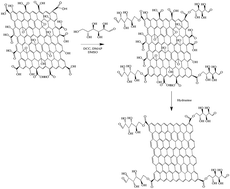Covalently functionalized graphene with d-glucose and its reinforcement to poly(vinyl alcohol) and poly(methyl methacrylate)
Abstract
Chemically functionalized graphene has been synthesized by covalently grafting D-glucose on graphene for the first time through an esterification reaction. The D-glucose functionalized graphene was further applied in the preparation of poly(vinyl alcohol) and poly(methyl methacrylate) nanocomposites. The thermal and mechanical properties of the prepared nanocomposites were then investigated. It was demonstrated that the D-glucose was grafted on the surface of the graphene through a covalent attachment. The chemically functionalized graphene had better dispersibility in both water and dimethylformamide than the pristine graphene. The better dispersion of the functionalized graphene in both aqueous and organic solvents simplified the preparation of the polymer nanocomposites. It was found that the D-glucose grafted graphene dispersed homogeneously in both poly(vinyl alcohol) and poly(methyl methacrylate) matrices, increasing the thermal and mechanical properties of the polymers at the same time. The phenomena were ascribed to the introduction of the D-glucose, which induced strong hydrogen bonding interactions between the functionalized graphene and the polymers. The results of this study indicate that this is an effective approach for preparing well-dispersed graphene-based polymer nanocomposites by covalently attaching functional molecules on the surface of graphene.


 Please wait while we load your content...
Please wait while we load your content...